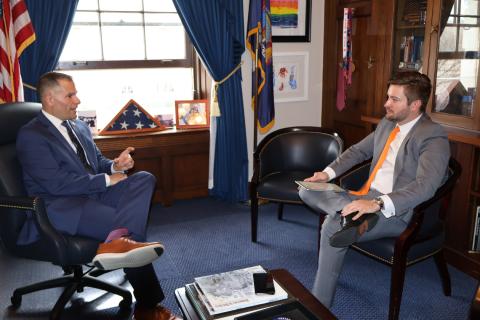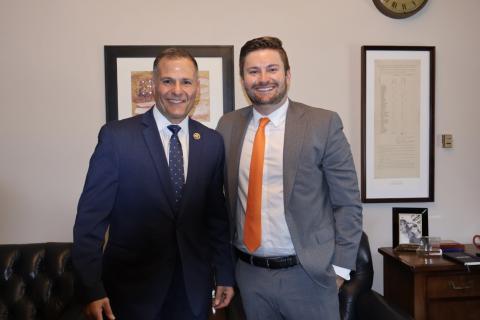Q&A with Rep. Marc Molinaro (NY)

by Reid Dagul, NSSGA
NSSGA's Government Affairs staff is excited to present a Q&A with Representative Marc Molinaro of New York. This interview covers Rep. Molinaro's perspective on the aggregates industry, his experience as a legislator and public servant, his focus in Congress and more.
NSSGA members are responsible for the essential raw materials found in every home, building, road, bridge and public works project in the United States. What do you think are some of the challenges for our industry?
I am very familiar with NSSGA members and understand the important role they have in our nation’s infrastructure. I will also say that the challenge for NSSGA members is that, for whatever reason, there are just too many people who don’t understand you have to extract the resources to build the thing. So, the challenge has always been to make sure that we have access to the actual resources necessary to ultimately build the driveway needed or to construct the pipe and the water sewer facilities relied on. It is always an adversarial process that, unfortunately, shouldn’t be.
You were once the youngest mayor in America. Do you think your age made you have a different approach towards legislating and your views on infrastructure?
I was very deliberate and made sure people knew I didn’t know everything, and that, by the way, hurt me to some degree. As an 18-year-old mayor I wanted to learn everything I could. To the point, I met with the engineers when we were on the road, doing the measuring and doing the surveying because I wanted to know how a project worked when we did the sewer plant advancement. I wanted to understand the technology when we had a water main break. I wanted to be in the hole fixing the water main, you know, and working hand-in-hand with the people doing the actual work.

How did your experiences as a former mayor and state legislator help prepare you for your role in Congress?
As the mayor of a town that was incorporated in the 1800s, there was a lot of aging infrastructure that can be challenging. For example, we faced a problem with a development project. There was a massive new development that had been built and the developer declared bankruptcy, so the roads weren’t paved. We needed to be creative and ensure we got those roads up to spec and ultimately paved. We worked with a couple of local providers, a couple of your members who provided us with the product and suddenly the roads are done.
People want to go home and feel comfortable, safe and proud about where they live. That means it’s the government’s job to make providing that quality of life a priority. NSSGA members certainly understand that since they are not only building the roads but also serving the communities where they live.
What’s been your primary focus in Congress?
So first, I wanted to serve on T&I because of my local government experience. T&I is bipartisan, and we move legislation most of the time without any fanfare, almost always in an overwhelmingly bipartisan way. Chairman Sam Graves (MO) does a good job of keeping members informed. Our subcommittee chairs, Garret Graves (LA) and others are really good at engaging members and using the talents that exist on the committee. Serving on it was a priority for me.
How do you assess the balance between state and federal involvement and local infrastructure projects?
We have so many agencies in this country that have some sort of jurisdiction over infrastructure. The balance between regional, state and national government is critically important. The average person will trust their village mayor and believe their local council person that projects will get done. Relying on local government to be the effective mechanism, the vehicle to move projects is critically important. We need the local government to get the trust, the confidence and the communication on projects. The problem is the federal government needs to give all the resources to do that.
Why can’t the New York State Highway Division provide the engineering assistance to help a small village of 1,500 people do the work? There’s no reason why. But we don’t allow that sort of partnership. I’d love to see the federal government, while we’re moving infrastructure dollars, establish contractual block rights to a municipality. Say you have 15 roads you need to pave; we’ll have some water lines you need to put in. It would be best if you brought them together. Not the other way around. So, we’ll give you $4.5 million by contract, and you can use a certain percentage to do the design. And when you’re done, it’s done.
However, we don’t do projects that way even though it would be an effective way of bridging the local-federal-state divide.

The process becomes so burdensome that many of our dollars have been eaten up by infrastructure or by inflation.
Absolutely, and even worse when you face regulatory conflict. I’m all for environmental regulation. I’ve dealt with New York State’s Environmental Quality Review Act since 1994. So, I get it, but we have duplicative reviews that produce different results, and that’s not healthy either. If you’re a state like New York or California, which has strict environmental reviews as it is, why do we need the NEPA Act? The state regulations are tough enough.
So, you think the strictest regulatory standard should be the standard?
I think we should streamline the standard. But yes, I have a situation where instead of requiring federal and state, it would be most effective just to require the state to allow that process. Again, you’re going to have local investment and local providers on projects that are local. Also, one of my focuses is trying to enhance and streamline the permitting process.
That’s a great ending point since NSSGA members definitely agree with that. Thank you again for your time and for being such a great supporter of our industry.
Originally published in Sep./Oct. 2024 Stone, Sand & Gravel Review.

